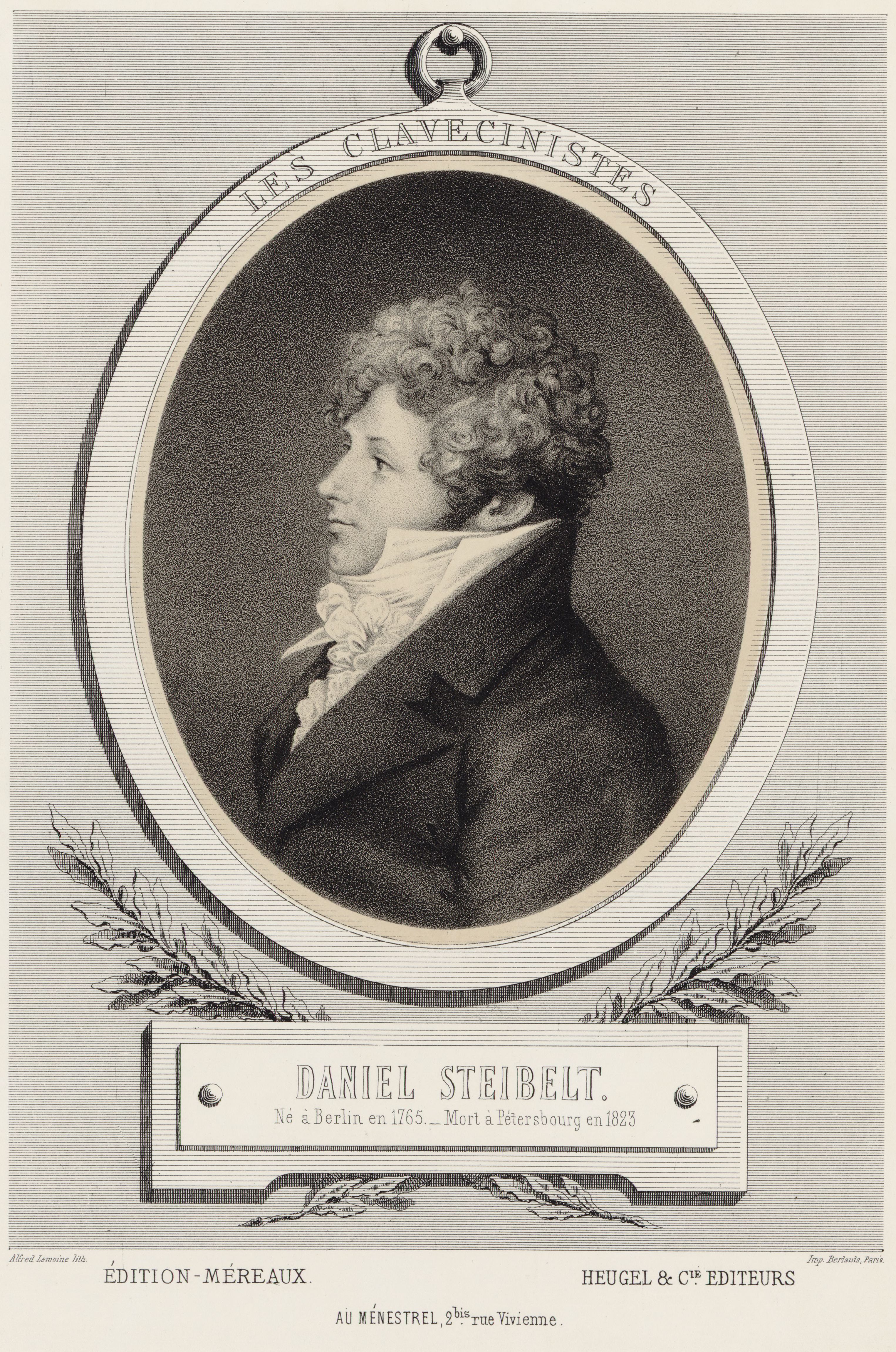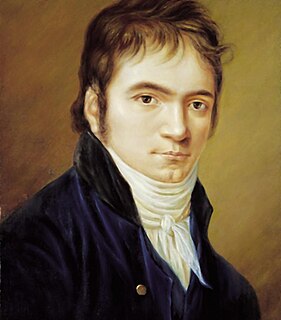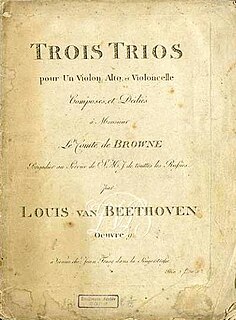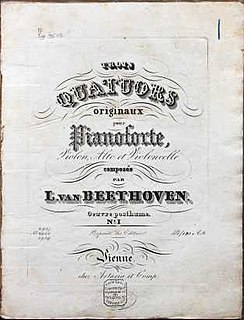Related Research Articles

The Piano Sonata No. 14 in C-sharp minor, marked Quasi una fantasia, Op. 27, No. 2, is a piano sonata by Ludwig van Beethoven. It was completed in 1801 and dedicated in 1802 to his pupil Countess Giulietta Guicciardi. The popular name Moonlight Sonata goes back to a critic's remark after Beethoven's death.

Ludwig van Beethoven composed his Violin Concerto in D major, Op. 61, in 1806. Its first performance by Franz Clement was unsuccessful and for some decades the work languished in obscurity, until revived in 1844 by the then 12-year-old violinist Joseph Joachim with the orchestra of the London Philharmonic Society conducted by Felix Mendelssohn. Since then it has become one of the best-known violin concertos.

Ludwig van Beethoven's Piano Sonata No. 7 in D major, Op. 10, No. 3, was dedicated to the Countess Anne Margarete von Browne, and written in 1798. This makes it contemporary with his three Op. 9 string trios, his three Op. 12 violin sonatas, and the violin and orchestra romance that became his Op. 50 when later published. The year also saw the premiere of a revised version of his second piano concerto, whose original form had been written and heard in 1795.

Ferdinand Ries was a German composer. Ries was a friend, pupil and secretary of Ludwig van Beethoven. He composed eight symphonies, a violin concerto, nine piano concertos, three operas, and numerous other works, including 26 string quartets. In 1838 he published a collection of reminiscences of his teacher Beethoven, co-written with Franz Wegeler. The symphonies, some chamber works—most of them with piano—his violin concerto and his piano concertos have been recorded, exhibiting a style which, given his connection to Beethoven, lies between the Classical and early Romantic styles.

The Violin Sonata No. 9, Op. 47 in A major, by Ludwig van Beethoven, is a sonata for piano and violin notable for its technical difficulty, unusual length, and emotional scope. It is commonly known as the Kreutzer Sonata after the violinist Rodolphe Kreutzer, to whom it was ultimately dedicated, but who thoroughly disliked the piece and refused to play it.

C minor is a minor scale based on C, consisting of the pitches C, D, E♭, F, G, A♭, and B♭. Its key signature consists of three flats. Its relative major is E♭ major and its parallel major is C major.

Daniel Gottlieb Steibelt was a German pianist and composer. His main works were composed in Paris and in London, and he died in Saint Petersburg, Russia.

Ludwig van Beethoven's Concerto for Violin, Cello, and Piano in C major, Op. 56, commonly known as the Triple Concerto, was composed in 1803 and published in 1804 by Breitkopf & Härtel. The choice of the three solo instruments effectively makes this a concerto for piano trio, and it is the only concerto Beethoven ever completed for more than one solo instrument. A typical performance takes approximately thirty-seven minutes.

The Piano Concerto No. 2 in B-flat major, Op. 19, by Ludwig van Beethoven was composed primarily between 1787 and 1789, although it did not attain the form in which it was published until 1795. Beethoven did write a second finale for it in 1798 for performance in Prague, but that is not the finale that was published. It was used by the composer as a vehicle for his own performances as a young virtuoso, initially intended with the Bonn Hofkapelle. It was published in 1801 following Beethoven's Piano Concerto No. 1 in C major, which actually had been composed well after this piece in 1796 and 1797.

Ludwig van Beethoven's Piano Concerto No. 1 in C major, Op. 15, was written in 1795, then revised in 1800. The first performance took place on 18 December 1795 in Vienna with Beethoven himself as soloist. It was first published in 1801 in Vienna with dedication to his pupil Princess Anna Louise Barbara Odescalchi, known to her friends as "Babette".

Ludwig van Beethoven's Piano Sonata No. 27 in E minor, Op. 90 was written in the summer of 1814 – Beethoven's late Middle period – and dedicated to Prince Moritz von Lichnowsky, a friend and benefactor who was also the dedicatee of the Eroica Variations.
The Piano Sonata No. 19 in G minor, Op. 49, No. 1, and Piano Sonata No. 20 in G major, Op. 49, No. 2, are short sonatas by Ludwig van Beethoven, published in 1805. Both works are approximately eight minutes in length, and are split into two movements. These sonatas are referred to as the Leichte Sonaten to be given to his friends and students.

Ludwig van Beethoven's Piano Sonata No. 4, in E♭ major, Op. 7, sometimes nicknamed the Grand Sonata, is dedicated to his student Babette, the Countess Keglevics. This piano sonata was composed in Bratislava, in 1796, in November, during his visit of Keglevich Palace in Bratislava. Beethoven named it Great Sonata, because it was published alone, which was unusual for the time.

Piano Sonata No. 13 in E-flat major, Op. 27 No. 1, "Quasi una fantasia", is a sonata composed by Ludwig van Beethoven in 1800–1801.
Cello Sonatas No. 1 and No. 2, Op. 5, are two sonatas for cello and piano written by Ludwig van Beethoven in 1796, while he was in Berlin. While there, Beethoven met the King of Prussia Friedrich Wilhelm II, an ardent music-lover and keen cellist. Although the sonatas are dedicated to Friedrich Wilhelm II, Ferdinand Ries tells us that Beethoven "played several times at the court, where he also played the two cello sonatas, opus 5, composed for Duport and himself". Although Jean-Pierre Duport was one of the King's teachers, it is now thought to have been his brother Jean-Louis Duport who had the honor of premiering these sonatas.

Vaterländischer Künstlerverein was a collaborative musical publication or anthology, incorporating 83 variations for piano on a theme by Anton Diabelli, written by 51 composers living in or associated with Austria. It was published in two parts in 1823 and 1824, by firms headed by Diabelli. It includes Ludwig van Beethoven's Diabelli Variations, Op. 120, as well as single variations from 50 other composers including Carl Czerny, Franz Schubert, Johann Nepomuk Hummel, Ignaz Moscheles, Friedrich Kalkbrenner, Franz Liszt, and a host of lesser-known names including a son of Wolfgang Amadeus Mozart and others now largely forgotten.

The three String Trios, Op. 9 were composed by Ludwig van Beethoven in 1797–98. He published them in Vienna in 1799, with a dedication to his patron Count Johann Georg von Browne (1767–1827). They were first performed by the violinist Ignaz Schuppanzigh with two colleagues from his string quartet. According to the violinist and conductor Angus Watson, these were probably Franz Weiss on viola and either Nikolaus Kraft or his father Anton on cello. Each of the trios consists of four movements:

The Piano Quartets, WoO 36, by Ludwig van Beethoven are a set of three piano quartets, completed in 1785 when the composer was aged 15. They are scored for piano, violin, viola and cello. He composed a quartet in C major, another in E-flat major, and a third in D major. They were first published posthumously in 1828, however numbered in a different order: Piano Quartet No. 1 in E-flat major, Piano Quartet No. 2 in D major, and Piano Quartet No. 3 in C major.
The Sonata in D major for piano four-hands, Op. 6, by Ludwig van Beethoven was published by Artaria in October 1797. It has two movements, and is used for teaching piano. A musical pattern used at its beginning and ending is similar to a pattern used later by Beethoven in the Symphony No. 5.
References
- ↑ Schmidt, Hans (1970). Ludwig van Beethoven: Bicentennial Edition (Print). Germany: Deutsche Grammophon Gesellschaft. p. 160, 163.